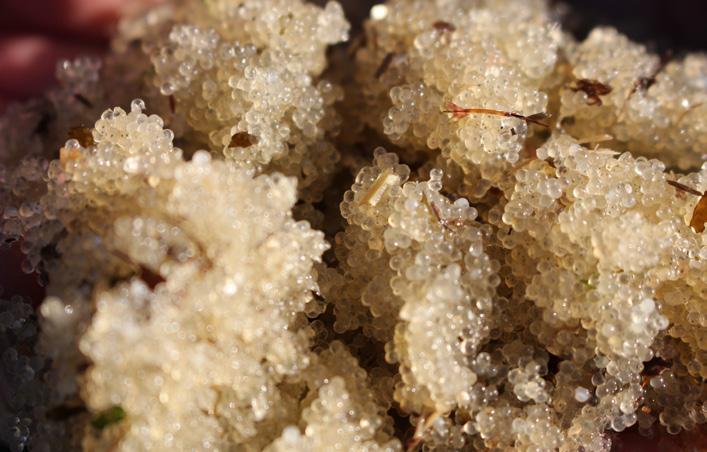
4 minute read
Welcoming the return of HERRING
from Fjord | Spring 2021
by Imagination
Stella Wenstob | Story & Pictures
Mid-March last year we were greeted with the spectacle of the herring spawn in Dabob Bay between Quilcene and Brinnon. The water went white with milt released by the male fish and the female’s eggs stuck to eel grass and other seaweeds like tiny, opaque grapes. The ocean was alive with sea lions, harbor seals, herons, sea gulls, eagles, and even the occasional killer whale, all taking advantage of this keystone forage fish and its roe.
The Pacific Herring is a small, schooling fish which returns to the same area to spawn. It ranges from Southern California’s Baja Peninsula up into Alaska, the Bering Strait, and South into Japan. It prefers protected waters and estuaries to spawn, making Dabob Bay’s long meandering tidelands a natural spot. Before overfishing and the destruction of spawning grounds in the late 20th century affected the herring stocks, herring would have spawned in nearly all of the shallow bays and inlets along the Hood Canal and Puget Sound. However, thanks to careful management, restoration of eelgrass beds, and just sheer luck, the Quilcene Stock are making a strong come back.
Observing the sea bleach with milt is a rare treat that Dabob Bay offers. Dosewallips State Park, Seal Rock Campground, and the Dabob Bay Natural Area Preserve offer potentially good viewing spots.
With binoculars, stand on the shore and look for the sea gulls first. A congregation of gulls out over the water usually is a tell-tale sign of a herring “ball.” A herring ball is a boiling look to the water as a school of herring twists and turns – usually because the school is being pursued by underwater predators, such as salmon, ducks, harbor seals, and/or sea lions.
If you are watching from a dock or pier you will notice that the herring’s whole body flashes silver as the fish darts and swims– this is opposed to pilchards (another schooling fish) which only flashes in the gill area. The 4-to-8-inch fish are dark on top with silver undersides, that help them camouflage in the water, but viewing from above they are given away by the flashes of silver.
If you walk out on to the beach to get a closer look, watch your feet. Don’t step on the millions of small eggs. One female can lay up to 20,000 eggs in one spawn! As the whole female population of the school goes into spawn, one school may produce up to 6,000,000 eggs per square meter! Unfortunately, due to predation the survivability of the offspring is very low, with only one out of every ten thousand eggs laid expected to survive to adulthood.

Native Americans have long valued the roe and fish for food. Researchers McKechnie and Moss (2016) recently demonstrated that herring were a prime food source to Native Americans.
After surveying archaeological sites from Northern British Columbia to Puget Sound, researchers found herring bones in the majority in a dominant number of the sites. Place names also echo the importance placed upon herring stocks. Ethnologist, William Elmendorf recorded that the beach to the east of Quilcene Bay, was known as a “landing for herring,” by the Twana speaking people. FJORD
Native Americans harvest roe by laying spruce or hemlock boughs in spawning pools for the female fish to lay their eggs upon. This creates convenient bundles of eggs, these may then be plucked from the branches or dried in place. The fish were traditionally harvested using a variety of methods. Intertidal traps or weirs made of stones or woven sticks would contain the fish when the tide regressed. Netting from the shore and between canoes was also effective.
Another method utilized was “herring rakes.” A long pole resembling an 8-to-10-foot comb with teeth made of fire-hardened wood, bone, or later nails, would be swept over the side of the boat, thereby impaling the fish and “raking” them into the canoe.
Since the late 19th century, the fish was processed by commercial fishers for a variety of uses: for fish oil; tinned, pickled and fresh for food; made into meal for fish farms; bait for sports fishing; and the roe is popular amongst international Asian markets for food. Today bait, roe, and fish food are still the prime uses for commercial harvest. However, dwindling stocks and a historically unsustainable fishing process has led the Pacific Herring fishery to be the subject of constant closures and protest.
In Canada and Alaska, there are festivals each March celebrating the return of the Pacific Herring. This year many of these host a virtual component – making these events international to anyone with an internet connection. Why not support a Canadian event? Hornby Island’s 5th Annual HerringFest offers videos and educational lectures.
Pacific Herring as a spectator sport is always rewarding. Low tide is best for viewing the action. Don your gumboots and hit the beach!










